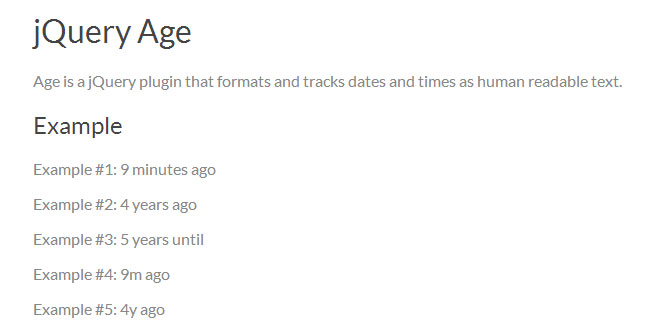Download
Demo
- Overview
- Documents
Age is a jQuery plugin that formats and tracks dates and times as human readable text.
Source: ksylvest.github.io

Jul 27, 2014 in Date & Time 3664 views
Age is a jQuery plugin that formats and tracks dates and times as human readable text.
Source: ksylvest.github.io
1. INCLUDE JS FILES
<script src="https://ajax.googleapis.com/ajax/libs/jquery/2.0.2/jquery.min.js" type="text/javascript"></script> <script src="javascript/jquery.age.js" type="text/javascript"></script>
2. HTML
<time datetime="2010-01-01T12:00:00Z" class="age">January 1, 2010 12:00</time> <time datetime="2020-01-01T12:00:00Z" class="age">January 1, 2020 12:00</time>
3. JAVASCRIPT
$('.age').age();
4. OPTIONS
Age supports a number of configuration settings for customizing the language and intervals:
$('.age').age({
interval: 10000,
suffixes: {
past: "ago",
future: "until",
},
formats: {
now: "now"
singular: {
seconds: "a second",
minutes: "a minute",
hours: "an hour",
days: "a day",
weeks: "a week",
months: "a month",
years: "a year",
},
plural: {
seconds: "{{amount}} seconds",
minutes: "{{amount}} minutes",
hours: "{{amount}} hours",
days: "{{amount}} days",
weeks: "{{amount}} weeks",
months: "{{amount}} months",
years: "{{amount}} years",
},
},
});
);
Age also supports passing in a whitelist of allowed units (i.e. not showing units in weeks or months ever):
$('.age').age({ units: ["days", "hours", "minutes"] });
Tagged with:
jquery age
jquery plugin
format date
track dates
format time
track time
human readable text
age
Related Articles
 JS Tutorial
JS Tutorial